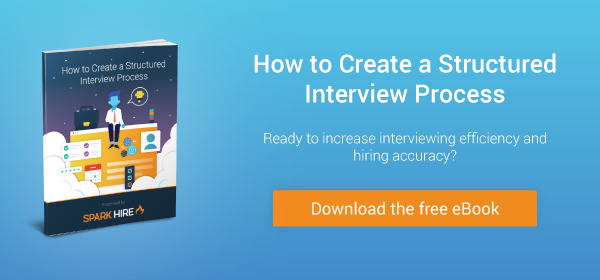Don’t let today’s trend of innovative, creative hiring processes scare you away from the world of structure and repetition. While you likely have a systematic process for outreach, sourcing, and onboarding, your interview process may not follow suit.
A structured interview process provides a fixed format for both candidates and hiring pros. Candidates receive the same opportunities and share similar, positive experiences. At the same time, your hiring team has a streamlined process to evaluate everyone accurately and fairly.
Unfortunately, structured interview processes are often stereotyped as boring, mundane, and unnecessarily repetitive. Push past this mindset and take a moment to consider if structured interviews might be the solution for you. Here are four signs you should be using a structured interview process:
1. Ill-fitting candidates slip through the process
If competition for talent feels strained, you’re not alone. You might be tempted to rush the hiring process in hopes of landing top talent before competitors, but moving too quickly means substandard candidates can slip through undetected.
If your current approach leads to ill-fitting candidates making it to final rounds or even being hired, the structured interview process could resolve your issues. Structured interviews allow hiring pros to quickly and fairly evaluate candidates through standardized interview questions and evaluation criteria.
2. Your hiring team can’t get on the same page
Cohesion is critical for effective hiring decisions. If your team is constantly disagreeing on candidate choices, has issues making final hiring decisions, or always faces a slew of other hiccups, you have a significant problem on your hands.
A structured interview process puts everyone on the same page from the very start because it allows you to craft questions together and follow identical guidelines when evaluating candidates.
Kickstart collaboration with a structured interview process by evaluating what both employees and hiring decision-makers view as the most important factors qualifying a candidate. Ask them to rank a set of criteria on a scale from most to least valuable. If there are major disagreements over prioritization, open the floor for discussion so you can reach an agreement.
3. Bias is prevalent
Bias is often unconscious. It can be as simple as forming a connection over alumni status or a hobby. While personal connections may feel relevant, they can lead to missing signs of candidates not being highly qualified for a role.
Recruiters are placing less importance on these types of connections, and structured interviews can help cut down on bias. Careful formatting and preparation leave little room for bias to seep into the interview process because candidates are asked the same questions, both role-specific and general interview questions.
4. Your candidate experience is down
Your interview process can make it or break it for a candidate. If you notice people aren’t making it to the later rounds of interviews, or even accept a job offer and then back out, it could be a sign of poor candidate experience.
Structured interviews improve this experience because they decrease time-to-hire, keep the process simple and consistent, and help candidates feel they’re being evaluated fairly.
One-way interviews are a unique and insightful way to enhance structured interviews for both candidates and your team. All applicants have access to the same interview experience. What’s more, they can complete the interview anytime, anywhere. One-way interviews are then quickly reviewed by the team to speed up and streamline your evaluation process.












